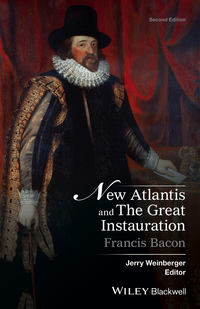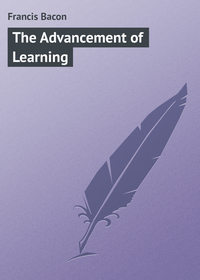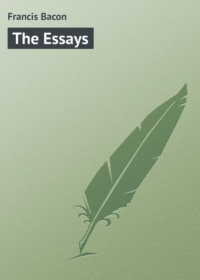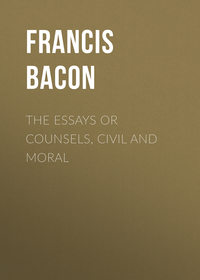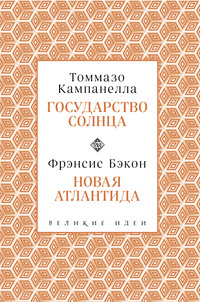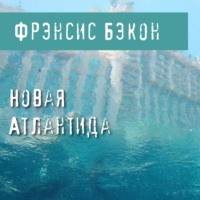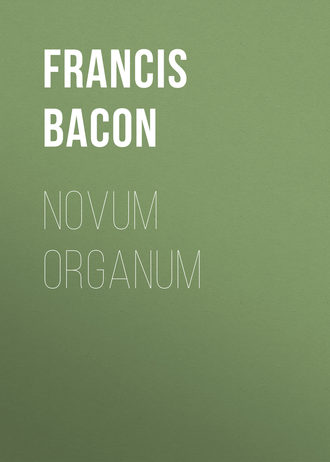 полная версия
полная версияNovum Organum
Again, for example’s sake, let the required nature be taste or the power of tasting. The following instances are constitutive: 1. Those who do not smell, but are deprived by nature of that sense, do not perceive or distinguish rancid or putrid food by their taste, nor garlic from roses, and the like. 2. Again, those whose nostrils are obstructed by accident (such as a cold) do not distinguish any putrid or rancid matter from anything sprinkled with rose-water. 3. If those who suffer from a cold blow their noses violently at the very moment in which they have anything fetid or perfumed in their mouth, or on their palate, they instantly have a clear perception of the fetor or perfume. These instances afford and constitute this species or division of taste, namely, that it is in part nothing else than an internal smelling, passing and descending through the upper passages of the nostrils to the mouth and palate. But, on the other hand, those whose power of smelling is deficient or obstructed, perceive what is salt, sweet, pungent, acid, rough, and bitter, and the like, as well as any one else: so that the taste is clearly something compounded of the internal smelling, and an exquisite species of touch which we will not here discuss.
Again, as another example, let the required nature be the communication of quality, without intermixture of substance. The instance of light will afford or constitute one species of communication, heat and the magnet another. For the communication of light is momentary and immediately arrested upon the removal of the original light. But heat, and the magnetic force, when once transmitted to or excited in another body, remain fixed for a considerable time after the removal of the source.
In fine, the prerogative of constitutive instances is considerable, for they materially assist the definitions (especially in detail) and the divisions or partitions of natures, concerning which Plato has well said, “He who can properly define and divide is to be considered a god.”117
XXVII. In the sixth rank of prerogative instances we will place similar or proportionate instances, which we are also wont to call physical parallels, or resemblances. They are such as exhibit the resemblances and connection of things, not in minor forms (as the constitutive do), but at once in the concrete. They are, therefore, as it were, the first and lowest steps toward the union of nature; nor do they immediately establish any axiom, but merely indicate and observe a certain relation of bodies to each other. But although they be not of much assistance in discovering forms, yet they are of great advantage in disclosing the frame of parts of the universe, upon whose members they practice a species of anatomy, and thence occasionally lead us gently on to sublime and noble axioms, especially such as relate to the construction of the world, rather than to simple natures and forms.
As an example, take the following similar instances: a mirror and the eye; the formation of the ear, and places which return an echo. From such similarity, besides observing the resemblance (which is useful for many purposes), it is easy to collect and form this axiom. That the organs of the senses, and bodies which produce reflections to the senses, are of a similar nature. Again, the understanding once informed of this, rises easily to a higher and nobler axiom; namely, that the only distinction between sensitive and inanimate bodies, in those points in which they agree and sympathize, is this: in the former, animal spirit is added to the arrangement of the body, in the latter it is wanting. So that there might be as many senses in animals as there are points of agreement with inanimate bodies, if the animated body were perforated, so as to allow the spirit to have access to the limb properly disposed for action, as a fit organ. And, on the other hand, there are, without doubt, as many motions in an inanimate as there are senses in the animated body, though the animal spirit be absent. There must, however, be many more motions in inanimate bodies than senses in the animated, from the small number of organs of sense. A very plain example of this is afforded by pains. For, as animals are liable to many kinds and various descriptions of pains (such as those of burning, of intense cold, of pricking, squeezing, stretching, and the like), so is it most certain, that the same circumstances, as far as motion is concerned, happen to inanimate bodies, such as wood or stone when burned, frozen, pricked, cut, bent, bruised, and the like; although there be no sensation, owing to the absence of animal spirit.
Again, wonderful as it may appear, the roots and branches of trees are similar instances. For every vegetable swells and throws out its constituent parts toward the circumference, both upward and downward. And there is no difference between the roots and branches, except that the root is buried in the earth, and the branches are exposed to the air and sun. For if one take a young and vigorous shoot, and bend it down to a small portion of loose earth, although it be not fixed to the ground, yet will it immediately produce a root, and not a branch. And, vice versâ, if earth be placed above, and so forced down with a stone or any hard substance, as to confine the plant and prevent its branching upward, it will throw out branches into the air downward.
The gums of trees, and most rock gems, are similar instances; for both of them are exudations and filtered juices, derived in the former instance from trees, in the latter from stones; the brightness and clearness of both arising from a delicate and accurate filtering. For nearly the same reason, the hair of animals is less beautiful and vivid in its color than the plumage of most birds, because the juices are less delicately filtered through the skin than through the quills.
The scrotum of males and matrix of females are also similar instances; so that the noble formation which constitutes the difference of the sexes appears to differ only as to the one being internal and the other external; a greater degree of heat causing the genitals to protrude in the male, while the heat of the female being too weak to effect this, they are retained internally.
The fins of fishes and the feet of quadrupeds, or the feet and wings of birds, are similar instances; to which Aristotle adds the four folds in the motion of serpents;118 so that in the formation of the universe, the motion of animals appears to be chiefly effected by four joints or bendings.
The teeth of land animals, and the beaks of birds, are similar instances, whence it is clear, that in all perfect animals there is a determination of some hard substance toward the mouth.
Again, the resemblance and conformity of man to an inverted plant is not absurd. For the head is the root of the nerves and animal faculties, and the seminal parts are the lowest, not including the extremities of the legs and arms. But in the plant, the root (which resembles the head) is regularly placed in the lowest, and the seeds in the highest part.119
Lastly, we must particularly recommend and suggest, that man’s present industry in the investigation and compilation of natural history be entirely changed, and directed to the reverse of the present system. For it has hitherto been active and curious in noting the variety of things, and explaining the accurate differences of animals, vegetables, and minerals, most of which are the mere sport of nature, rather than of any real utility as concerns the sciences. Pursuits of this nature are certainly agreeable, and sometimes of practical advantage, but contribute little or nothing to the thorough investigation of nature. Our labor must therefore be directed toward inquiring into and observing resemblances and analogies, both in the whole and its parts, for they unite nature, and lay the foundation of the sciences.
Here, however, a severe and rigorous caution must be observed, that we only consider as similar and proportionate instances, those which (as we first observed) point out physical resemblances; that is, real and substantial resemblances, deeply founded in nature, and not casual and superficial, much less superstitious or curious; such as those which are constantly put forward by the writers on natural magic (the most idle of men, and who are scarcely fit to be named in connection with such serious matters as we now treat of), who, with much vanity and folly, describe, and sometimes too, invent, unmeaning resemblances and sympathies.
But leaving such to themselves, similar instances are not to be neglected, in the greater portions of the world’s conformation; such as Africa and the Peruvian continent, which reaches to the Straits of Magellan; both of which possess a similar isthmus and similar capes, a circumstance not to be attributed to mere accident.
Again, the New and Old World are both of them broad and expanded toward the north, and narrow and pointed toward the south.
Again, we have very remarkable similar instances in the intense cold, toward the middle regions (as it is termed) of the air, and the violent fires which are often found to burst from subterraneous spots, the similarity consisting in both being ends and extremes; the extreme of the nature of cold, for instance, is toward the boundary of heaven, and that of the nature of heat toward the centre of the earth, by a similar species of opposition or rejection of the contrary nature.
Lastly, in the axioms of the sciences, there is a similarity of instances worthy of observation. Thus the rhetorical trope which is called surprise, is similar to that of music termed the declining of a cadence. Again – the mathematical postulate, that things which are equal to the same are equal to one another, is similar to the form of the syllogism in logic, which unites things agreeing in the middle term.120 Lastly, a certain degree of sagacity in collecting and searching for physical points of similarity, is very useful in many respects.121
XXVIII. In the seventh rank of prerogative instances, we will place singular instances, which we are also wont to call irregular or heteroclite (to borrow a term from the grammarians). They are such as exhibit bodies in the concrete, of an apparently extravagant and separate nature, agreeing but little with other things of the same species. For, while the similar instances resemble each other, those we now speak of are only like themselves. Their use is much the same with that of clandestine instances: they bring out and unite nature, and discover genera or common natures, which must afterward be limited by real differences. Nor should we desist from inquiry, until the properties and qualities of those things, which may be deemed miracles, as it were, of nature, be reduced to, and comprehended in, some form or certain law; so that all irregularity or singularity may be found to depend on some common form; and the miracle only consists in accurate differences, degree, and rare coincidence, not in the species itself. Man’s meditation proceeds no further at present, than just to consider things of this kind as the secrets and vast efforts of nature, without an assignable cause, and, as it were, exceptions to general rules.
As examples of singular instances, we have the sun and moon among the heavenly bodies; the magnet among minerals; quicksilver among metals; the elephant among quadrupeds; the venereal sensation among the different kinds of touch; the scent of sporting dogs among those of smell. The letter S, too, is considered by the grammarians as sui generis, from its easily uniting with double or triple consonants, which no other letter will. These instances are of great value, because they excite and keep alive inquiry, and correct an understanding depraved by habit and the common course of things.
XXIX. In the eighth rank of prerogative instances, we will place deviating instances, such as the errors of nature, or strange and monstrous objects, in which nature deviates and turns from her ordinary course. For the errors of nature differ from singular instances, inasmuch as the latter are the miracles of species, the former of individuals. Their use is much the same, for they rectify the understanding in opposition to habit, and reveal common forms. For with regard to these, also, we must not desist from inquiry, till we discern the cause of the deviation. The cause does not, however, in such cases rise to a regular form, but only to the latent process toward such a form. For he who is acquainted with the paths of nature, will more readily observe her deviations; and, vice versâ, he who has learned her deviations will be able more accurately to describe her paths.
They differ again from singular instances, by being much more apt for practice and the operative branch. For it would be very difficult to generate new species, but less so to vary known species, and thus produce many rare and unusual results.122 The passage from the miracles of nature to those of art is easy; for if nature be once seized in her variations, and the cause be manifest, it will be easy to lead her by art to such deviation as she was at first led to by chance; and not only to that but others, since deviations on the one side lead and open the way to others in every direction. Of this we do not require any examples, since they are so abundant. For a compilation, or particular natural history, must be made of all monsters and prodigious births of nature; of everything, in short, which is new, rare and unusual in nature. This should be done with a rigorous selection, so as to be worthy of credit. Those are most to be suspected which depend upon superstition, as the prodigies of Livy, and those perhaps, but little less, which are found in the works of writers on natural magic, or even alchemy, and the like; for such men, as it were, are the very suitors and lovers of fables; but our instances should be derived from some grave and credible history, and faithful narration.
XXX. In the ninth rank of prerogative instances, we will place bordering instances, which we are also wont to term participants. They are such as exhibit those species of bodies which appear to be composed of two species, or to be the rudiments between the one and the other. They may well be classed with the singular or heteroclite instances; for in the whole system of things, they are rare and extraordinary. Yet from their dignity, they must be treated of and classed separately, for they point out admirably the order and constitution of things, and suggest the causes of the number and quality of the more common species in the universe, leading the understanding from that which is, to that which is possible.
We have examples of them in moss, which is something between putrescence and a plant;123 in some comets, which hold a place between stars and ignited meteors; in flying fishes, between fishes and birds; and in bats, between birds and quadrupeds.124 Again,
Simia quam similis turpissima bestia nobisWe have also biformed fœtus, mingled species and the like.
XXXI. In the tenth rank of prerogative instances, we will place the instances of power, or the fasces (to borrow a term from the insignia of empire), which we are also wont to call the wit or hands of man. These are such works as are most noble and perfect, and, as it were, the masterpieces in every art. For since our principal object is to make nature subservient to the state and wants of man, it becomes us well to note and enumerate the works, which have long since been in the power of man, especially those which are most polished and perfect: because the passage from these to new and hitherto undiscovered works, is more easy and feasible. For if any one, after an attentive contemplation of such works as are extant, be willing to push forward in his design with alacrity and vigor, he will undoubtedly either advance them, or turn them to something within their immediate reach, or even apply and transfer them to some more noble purpose.
Nor is this all: for as the understanding is elevated and raised by rare and unusual works of nature, to investigate and discover the forms which include them also, so is the same effect frequently produced by the excellent and wonderful works of art; and even to a greater degree, because the mode of effecting and constructing the miracles of art is generally plain, while that of effecting the miracles of nature is more obscure. Great care, however, must be taken, that they do not depress the understanding, and fix it, as it were, to earth.
For there is some danger, lest the understanding should be astonished and chained down, and as it were bewitched, by such works of art, as appear to be the very summit and pinnacle of human industry, so as not to become familiar with them, but rather to suppose that nothing of the kind can be accomplished, unless the same means be employed, with perhaps a little more diligence, and more accurate preparation.
Now, on the contrary, it may be stated as a fact, that the ways and means hitherto discovered and observed, of effecting any matter or work, are for the most part of little value, and that all really efficient power depends, and is really to be deduced from the sources of forms, none of which have yet been discovered.
Thus (as we have before observed), had any one meditated on ballistic machines, and battering rams, as they were used by the ancients, whatever application he might have exerted, and though he might have consumed a whole life in the pursuit, yet would he never have hit upon the invention of flaming engines, acting by means of gunpowder; nor would any person, who had made woollen manufactories and cotton the subject of his observation and reflection, have ever discovered thereby the nature of the silkworm or of silk.
Hence all the most noble discoveries have (if you observe) come to light, not by any gradual improvement and extension of the arts, but merely by chance; while nothing imitates or anticipates chance (which is wont to act at intervals of ages) but the invention of forms.
There is no necessity for adducing any particular examples of these instances, since they are abundant. The plan to be pursued is this: all the mechanical, and even the liberal arts (as far as they are practical), should be visited and thoroughly examined, and thence there should be formed a compilation or particular history of the great masterpieces, or most finished works in each, as well as of the mode of carrying them into effect.
Nor do we confine the diligence to be used in such a compilation to the leading works and secrets only of every art, and such as excite wonder; for wonder is engendered by rarity, since that which is rare, although it be compounded of ordinary natures, always begets wonder.
On the contrary, that which is really wonderful, from some specific difference distinguishing it from other species, is carelessly observed, if it be but familiar. Yet the singular instances of art should be observed no less than those of nature, which we have before spoken of: and as in the latter we have classed the sun, the moon, the magnet, and the like, all of them most familiar to us, but yet in their nature singular, so should we proceed with the singular instances of art.
For example: paper, a very common substance, is a singular instance of art; for if you consider the subject attentively, you will find that artificial substances are either woven by straight and transverse lines, as silk, woollen, or linen cloth, and the like; or coagulated from concrete juices, such as brick, earthenware, glass, enamel, porcelain and the like, which admit of a polish if they be compact, but if not, become hard without being polished; all which latter substances are brittle, and not adherent or tenacious. On the contrary, paper is a tenacious substance, which can be cut and torn, so as to resemble and almost rival the skin of any animal, or the leaf of vegetables, and the like works of nature; being neither brittle like glass, nor woven like cloth, but having fibres and not distinct threads, just as natural substances, so that scarcely anything similar can be found among artificial substances, and it is absolutely singular. And in artificial works we should certainly prefer those which approach the nearest to an imitation of nature, or, on the other hand, powerfully govern and change her course.
Again, in these instances which we term the wit and hands of man, charms and conjuring should not be altogether despised, for although mere amusements, and of little use, yet they may afford considerable information.
Lastly, superstition and magic (in its common acceptation) are not to be entirely omitted; for although they be overwhelmed by a mass of lies and fables, yet some investigation should be made, to see if there be really any latent natural operation in them; as in fascination, and the fortifying of the imagination, the sympathy of distant objects, the transmission of impressions from spirit to spirit no less than from body to body, and the like.
XXXII. From the foregoing remarks, it is clear that the last five species of instances (the similar, singular, deviating and bordering instances, and those of power) should not be reserved for the investigation of any given nature, as the preceding and many of the succeeding instances must, but a collection of them should be made at once, in the style of a particular history, so that they may arrange the matter which enters the understanding, and correct its depraved habit, for it is necessarily imbued, corrupted, perverted and distorted by daily and habitual impressions.
They are to be used, therefore, as a preparative, for the purpose of rectifying and purifying the understanding; for whatever withdraws it from habit, levels and planes down its surface for the reception of the dry and pure light of true notions.
These instances, moreover, level and prepare the way for the operative branch, as we will mention in its proper place when speaking of the practical deductions.
XXXIII. In the eleventh rank of prerogative instances we will place accompanying and hostile instances. These are such as exhibit any body or concrete, where the required nature is constantly found, as an inseparable companion, or, on the contrary, where the required nature is constantly avoided, and excluded from attendance, as an enemy. From these instances may be formed certain and universal propositions, either affirmative or negative; the subject of which will be the concrete body, and the predicate the required nature. For particular propositions are by no means fixed, when the required nature is found to fluctuate and change in the concrete, either approaching and acquired, or receding and laid aside. Hence particular propositions have no great prerogative, except in the case of migration, of which we have spoken above. Yet such particular propositions are of great use, when compared with the universal, as will be mentioned in its proper place. Nor do we require absolute affirmation or negation, even in universal propositions, for if the exceptions be singular or rare, it is sufficient for our purpose.
The use of accompanying instances is to narrow the affirmative of form; for as it is narrowed by the migrating instances, where the form must necessarily be something communicated or destroyed by the act of migration, so it is narrowed by accompanying instances, where the form must necessarily be something which enters into the concretion of the body, or, on the contrary, is repugnant to it; and one who is well acquainted with the constitution or formation of the body, will not be far from bringing to light the form of the required nature.
For example: let the required nature be heat. Flame is an accompanying instance; for in water, air, stone, metal, and many other substances, heat is variable, and can approach or retire; but all flame is hot, so that heat always accompanies the concretion of flame. We have no hostile instance of heat; for the senses are unacquainted with the interior of the earth, and there is no concretion of any known body which is not susceptible of heat.
Again, let solidity be the required nature. Air is a hostile instance; for metals may be liquid or solid, so may glass; even water may become solid by congelation, but air cannot become solid or lose its fluidity.
With regard to these instances of fixed propositions, there are two points to be observed, which are of importance. First, that if there be no universal affirmative or negative, it be carefully noted as not existing. Thus, in heat, we have observed that there exists no universal negative, in such substances, at least, as have come to our knowledge. Again, if the required nature be eternity or incorruptibility, we have no universal affirmative within our sphere, for these qualities cannot be predicated of any bodies below the heavens, or above the interior of the earth. Secondly, to our general propositions as to any concrete, whether affirmative or negative, we should subjoin the concretes which appear to approach nearest to the non-existing substances; such as the most gentle or least-burning flames in heat, or gold in incorruptibility, since it approaches nearest to it. For they all serve to show the limit of existence and non-existence, and circumscribe forms, so that they cannot wander beyond the conditions of matter.


